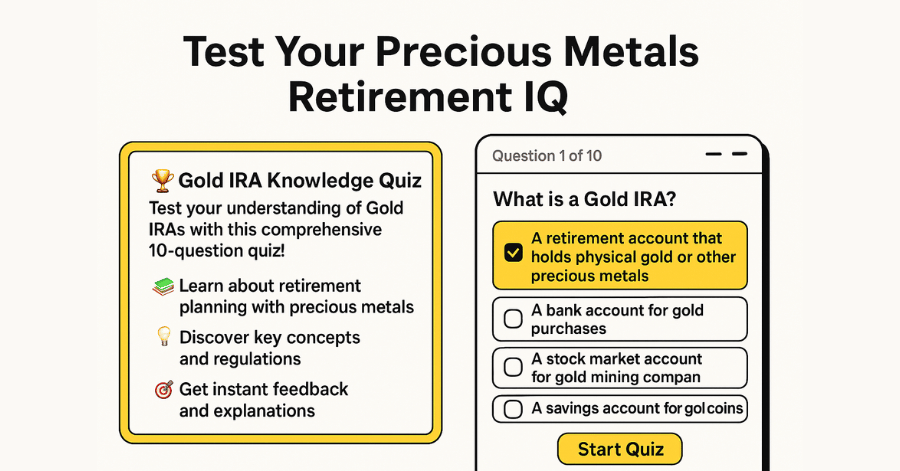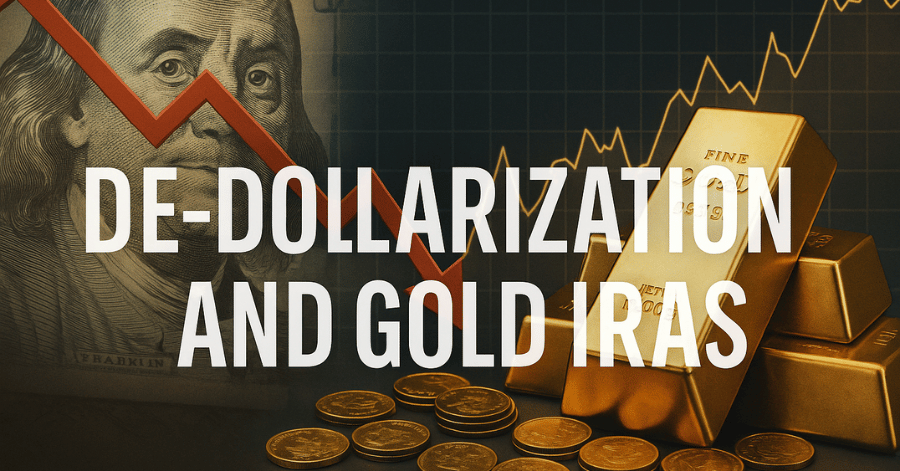Key Takeaways:
- De-Dollarization & Your Retirement: Learn how global currency shifts like the “Rio Reset” are driving interest in using a Gold IRA to protect retirement savings.
- Gold as a Safe-Haven Asset: Gold has historically acted as an inflation hedge and a “financial shield,” preserving wealth during periods of economic uncertainty.
- Diversify Your Portfolio with a Gold IRA: A Gold IRA allows you to hold physical, IRS-approved precious metals, offering a powerful way to diversify beyond stocks and bonds.
- The Gold IRA Setup Process: Investing requires choosing a specialized custodian, funding the account (often via rollover), and storing your gold in a secure, IRS-approved depository.
- Understand the Risks and Costs: Be aware that a Gold IRA has unique risks, including price volatility, and comes with setup, custodian, and storage fees.
- Seek Professional Guidance: Always research reputable Gold IRA companies and consult a financial advisor to ensure this investment aligns with your personal financial goals.
Read Our Article: Rio Reset Dollar Shakedown
 Is Gold Your Retirement Shield?
Is Gold Your Retirement Shield?
Introduction
Gold IRA for De-Dollarization: This financial strategy is gaining attention as the global landscape buzzes with terms like “de-dollarization” and the “Rio Reset.” These terms signal potential shifts in currency dominance. With such changes being discussed more intensely, many people are re-evaluating the security of their retirement savings.
This article explores how a Gold IRA, specifically in the context of de-dollarization, offers a path to resilience. Could investing in physical gold through this self-directed IRA truly provide a “time-tested financial shield”? Can it protect against the uncertainties of de-dollarization and related economic pressures? We will examine these critical questions.
The Shifting Landscape: De-dollarization and the Rio Reset
The term “de-dollarization” refers to a global trend where countries aim to reduce their reliance on the U.S. dollar for international trade and financial reserves. This movement has gained traction for various economic and geopolitical reasons. A key focal point in these discussions is the “Rio Reset,” a term associated with meetings of BRICS+ nations where strategies to accelerate this de-dollarization drive are reportedly on the agenda. Their de-dollarization drive has reportedly made significant progress over the last two years.
While the complete replacement of the dollar is a complex undertaking, these efforts signify a potential move towards a more multipolar currency system. Such currency shifts naturally lead individuals to consider assets in precious metals that have historically offered stability during financial transitions, with gold being a prominent example.
Gold’s Enduring Appeal as a Safe Haven
For centuries, gold has held a special status. People often see it as a reliable store of value. This is especially true during uncertain economic times. But why does gold maintain this appeal?
One key reason is its perceived ability to act as a hedge. It can protect against inflation. When paper currencies lose purchasing power, gold has historically tended to hold its value. Sometimes, its value even increases. Gold can offer much-needed protection against a decreasing value of the dollar.
Many also view gold as a shield against broader market risks. It can help during economic downturns. Unlike stocks or bonds, physical gold is a tangible asset. Its worth does not rely on any single government or financial institution. This quality makes it a “time-tested financial shield” for some investors. They use it to preserve wealth and add resilience to their financial plans.
Understanding Gold IRAs

So, how can one invest in gold for retirement? One popular method is through a Gold IRA. A Gold IRA is a type of self-directed Individual Retirement Account. It allows investors to hold physical gold. Often, other precious metals like silver, platinum, or palladium can also be included. These assets are held within a tax-advantaged retirement plan.
The main goal of a Gold IRA is often to diversify a retirement portfolio. Many see it as a way to shield savings. It can help protect against inflation. It may also offer protection during economic downturns. Instead of holding only paper assets, like stocks or bonds, a Gold IRA lets you include tangible gold. This gold must meet specific purity standards set by the IRS.
Setting up and managing a Gold IRA involves choosing a custodian. This custodian must specialize in precious metals IRAs. They handle the purchase and storage of the gold. The gold is stored in an IRS-approved depository. Gold IRAs are gaining momentum as a strategy for these protective reasons. They provide a regulated way to include a “time-tested financial shield” in long-term savings.
Important Points to Consider with Gold IRAs
While Gold IRAs offer potential benefits for wealth preservation, it is wise to consider several points. Investing in a Gold IRA is a significant financial decision. Doing thorough research is very important.
First
Understand that all investments carry some level of risk. The price of gold can fluctuate based on market conditions. While it’s often sought to protect against inflation and market risk, gold’s value is not guaranteed to always increase.
Second
Be aware of associated costs. Gold IRAs typically involve fees. These can include setup fees, annual custodian fees, and storage fees for the physical metal. It is crucial to get a clear understanding of all costs from any provider.
Third
Ensure you work with reputable companies. Choose an experienced Gold IRA custodian and a trustworthy precious metals dealer. Look into their track record, customer reviews, and transparency. For example, some sources mention specific dealers, indicating choices are available and research is needed.
Finally
Gold IRAs must follow specific IRS rules. This includes regulations on the types and purity of gold allowed. Contribution limits applicable to IRAs also apply. Understanding these rules is essential for compliance. Consulting with a qualified financial advisor can help determine if a Gold IRA aligns with your overall retirement strategy and risk tolerance.
Affiliate Disclosure: To support our mission of providing valuable financial analysis, this page may contain affiliate links. If you follow a link and make a purchase, we may earn a commission at no additional cost to you. We only recommend partners we thoroughly research and trust.
Frequently Asked Questions: Gold IRA for De-Dollarization
Tax Benefits & Implications
What are the tax advantages of a Gold IRA compared to owning physical gold directly?
Gold IRAs offer the same tax benefits as traditional or Roth IRAs. With a traditional Gold IRA, contributions may be tax-deductible, and taxes are deferred until withdrawal. Roth Gold IRAs use after-tax dollars but offer tax-free withdrawals in retirement. Owning physical gold outside an IRA means paying taxes on gains when sold, with no upfront deduction benefits.
Can I roll over my existing 401(k) or traditional IRA into a Gold IRA without penalties?
Yes, you can perform a direct rollover from a 401(k), 403(b), TSP, or traditional IRA into a Gold IRA without tax penalties, provided it’s done correctly within 60 days. This is called a “trustee-to-trustee transfer” and is the preferred method to avoid potential tax complications.
Contribution Limits & Investment Rules
What are the annual contribution limits for Gold IRAs in 2025?
Gold IRAs follow the same contribution limits as traditional IRAs: $7,000 per year for individuals under 50, and $8,000 per year for those 50 and older (including the $1,000 catch-up contribution). These limits apply to the total contributions across all your IRA accounts.
Which specific precious metals are IRS-approved for Gold IRAs?
The IRS requires precious metals to meet minimum fineness standards: gold (99.5% pure), silver (99.9% pure), platinum (99.95% pure), and palladium (99.95% pure). Approved products include American Eagle coins, Canadian Maple Leaf coins, and certain bars from accredited refiners. Collectible coins are generally prohibited.
Withdrawal Rules & Requirements
When can I withdraw from my Gold IRA, and what are the penalties?
Like traditional IRAs, withdrawals before age 59½ typically incur a 10% early withdrawal penalty plus income taxes. Required minimum distributions (RMDs) begin at age 73. The precious metals must be liquidated (sold) to make cash distributions, as you cannot take physical possession of the metals as a distribution.
Do Gold IRAs have required minimum distributions (RMDs)?
Yes, traditional Gold IRAs are subject to RMDs starting at age 73, just like regular IRAs. The custodian will typically sell a portion of your precious metals holdings to generate the required cash distribution, which is then taxable as ordinary income.
Practical Considerations
How long does it typically take to set up a Gold IRA?
The setup process usually takes 1-3 weeks, depending on how quickly you complete paperwork and fund the account. Rollovers from existing retirement accounts may take longer due to processing times between custodians. The actual purchase and storage of metals typically occurs within a few days of funding.
What happens to my Gold IRA if my custodian goes out of business?
Your precious metals are held in segregated storage at an IRS-approved depository, separate from the custodian’s assets. If a custodian fails, your metals remain your property and can be transferred to another qualified custodian. This is why choosing custodians with strong financial backing and insurance is important.
Storage & Security
Can I store my Gold IRA metals at home or in a personal safe deposit box?
No, IRS regulations require Gold IRA metals to be stored at an approved depository. Home storage or personal safe deposit boxes disqualify the IRA status and can result in the entire account value being treated as a taxable distribution plus penalties.
What’s the difference between segregated and non-segregated storage for Gold IRAs?
Segregated storage means your specific metals are individually identified and stored separately from other investors’ holdings. Non-segregated (or commingled) storage pools your metals with others of the same type. Segregated storage typically costs more but provides additional peace of mind and easier auditing.
Costs & Liquidity
How liquid are Gold IRA investments compared to stocks or bonds?
Gold IRAs are less liquid than traditional investments. To access funds, you must sell the metals through your custodian, which can take several days to weeks. Unlike stocks that can be sold instantly during market hours, precious metals sales require finding buyers and may involve shipping logistics.
Are there ongoing fees beyond the initial setup costs?
Yes, expect annual custodian fees ($100-$300), storage fees ($100-$300 per year), and potential insurance fees. Some custodians charge transaction fees for buying/selling metals. These ongoing costs can impact returns, especially for smaller account balances, so factor them into your investment decision.
Ready to Take Action?

If you are ready to take action and secure your retirement, you must act NOW.
Navigating a Changing Financial World
The discussions surrounding the “Rio Reset” and broader de-dollarization trends highlight a potentially evolving global financial landscape. For individuals planning for their retirement, these shifts can prompt a closer examination of long-term savings strategies, including considering a Gold IRA for De-Dollarization. Separately, gold has long been regarded as a store of value. It may offer protection against inflation, market risk, and a decreasing value of the dollar.
A Gold IRA presents one method for individuals to incorporate this “time-tested financial shield” into a diversified retirement plan. This option allows for holding physical gold. The aim is often to shield savings from some economic downturns and inflationary pressures.
However, like any investment, a Gold IRA is not a decision to be taken lightly. It requires careful research into reputable providers. Investors must also understand the associated costs and IRS regulations. Ultimately, whether a Gold IRA is a suitable strategy depends on an individual’s specific financial situation, retirement goals, and tolerance for risk. Seeking advice from a qualified financial professional is always a prudent step when making significant investment decisions. In an era of potential financial change, informed choices are key to building resilience.







